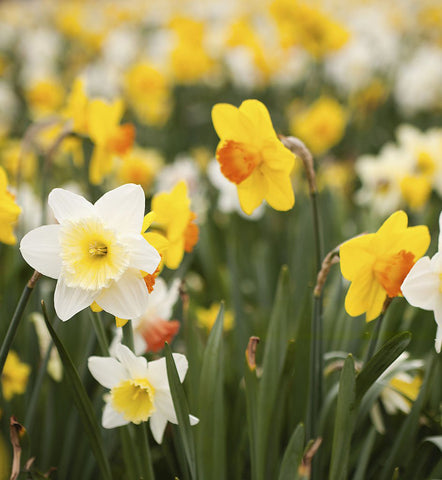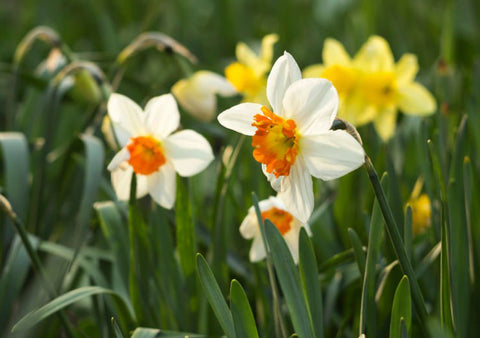The origins of the Narcissus flower.
Narcissus is a herbaceous plant, which is part of the Amaryllidaceae family .
It is a bulbous perennial plant with white flowers (yellow or orange depending on the species) composed of six petals and a crown. Depending on the variety, their long flowering period begins in winter, generally around February, and extends until June.
There are about fifty species, including the popular varieties “Poet's Narcissus” (Narcissus poeticus), “Paperwhite” (Narcissus papyraceus), the most fragrant of the Narcissus, as well as the daffodil (Narcissus jonquilla), with its sweet and pleasant fragrance.
Narcissus is a flower found in France growing wild in areas of moderate heat, such as damp meadows, undergrowth, and near watercourses such as riverbanks. It can be found on high plateaus in the Massif Central, in the Aubrac region, and in the Jura Mountains.
It also grows in Europe, North Africa, and Asia.
This flower, which grows near water points, gives it the particularity of its posture inclined towards the ground, which recalls the character of Greek mythology, Narcissus.
“Narcissus is a symbol of vanity and self-centeredness in Greek mythology. With his unparalleled beauty, he fell in love with his own image in a pool of water. Captivated by his reflection, and ignoring the attempts of the beautiful nymph Echo to bring him back to reality and lead him away from the pool, he languished in despair and died of hunger and thirst. His body then transformed into a flower, which would later bear his name.”

The Narcissus Harvest.
The head of the flower mainly contains the fragrant nectar, so it is this part that is picked during harvesting.
The extraction is then carried out by immersing several kilos of flowers in a vat containing volatile solvents, which once evaporated will produce the concrete. This paste is then diluted in alcohol, then filtered, in order to obtain the absolute containing the most fragrant molecules.
It takes 1.5 to 2 tons of Narcissus (which represents a quantity of approximately 800,000 flowers) to obtain 3 kg of concrete and therefore 1 kg of absolute which will be used to produce extracts for perfumery.
The addictive scent of Narcissus.
Narcissus is an incredibly fragrant flower, which gives off intense, almost narcotic scents, and which can cause migraines, depending on the variety and the intensity of their scent.
However, it has a captivating fragrance, both powerful and tender, with heady and sweet facets.
Since its stems are also treated during the extraction of the absolute, Narcissus also has a greener, herbaceous and earthier scent reminiscent of hay.

Properties of Narcissus.
Like many plants, Narcissus has medicinal properties, however, it is highly toxic to humans and animals.
For example, it has emetic properties and antispasmodic actions.
Also, once dried, the calming and sedative flowers can be used in infusion.
It is also used in cosmetics, such as shampoo and creams, for its softening and moisturizing properties.
However, Narcissus must be handled with caution, especially the bulb, as it contains toxic substances called alkaloids. It is also important to avoid contact with Narcissus sap, which is allergic and irritating.
Photo credits: IStock - (photo 1: vik898, Photo 2: Studio-Annika)





